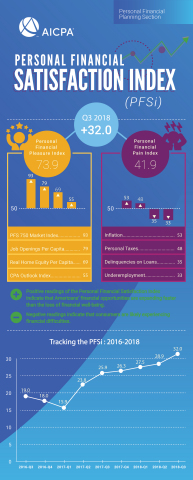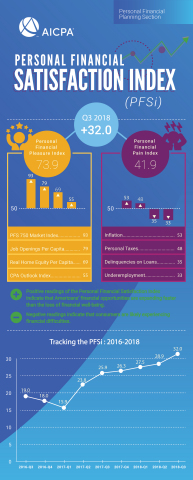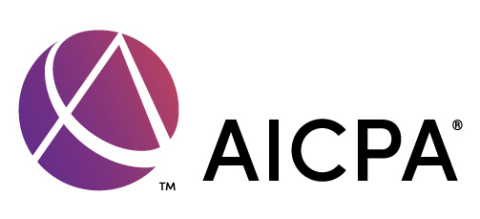NEW YORK--(BUSINESS WIRE)--A record number of available jobs and continued stock market growth have Americans experiencing their highest level of personal financial satisfaction in the 25-year history of the AICPA’s Personal Financial Satisfaction Index (PFSi). The new high, reached by the Q3 2018 PFSi released today, marks the fifth successive quarter in a row the index has set a record.
The PFSi is calculated as the Personal Financial Pleasure Index minus the Personal Financial Pain Index, with positive readings signaling that Americans are feeling more financial pleasure than pain. The Q3 PFSi measured 32, a 3.1-point increase from the prior quarter, the largest quarterly increase to the PFSi since Q2 2017. The increase was due to a modest gain (2.0 points) in the Personal Financial Pleasure Index which was boosted by a slight (1.1 point) drop in the Personal Financial Pain Index.
The Personal Financial Pleasure Index, at 73.9, is up 2.0 points from the previous quarter, continuing its steady increase and setting an all-time record for the seventh quarter in a row. The PFS 750 Market Index continues to be the biggest contributor to the Pleasure Index, now accounting for nearly one-third (31.5 percent) of its total value. The Q3 value is determined by the stock market’s closing position at the end of the first trading day of Q4, which for this reading was October 1st. Since then, the market has experienced a pullback that will be captured in the Q4 index, should the market not rebound in the interim. This AICPA proprietary stock index is comprised of the 750 largest companies trading on the US Market adjusted for inflation and per capita. In comparison to its Q2 level, it is up 5.3 points (6.0 percent) to 93 and has once again reached an all-time high.
“While it is great that the stock market's record performance is bolstering American’s financial satisfaction, it’s crucial for investors to keep in mind that pullbacks, like the one we’ve seen recently, are a regular occurrence for risk assets,” said Robert Westley, CPA/PFS member of the AICPAs Personal Financial Specialist Credential Committee. “Short-term volatility and pullbacks are the price we pay for riskier assets that provide a higher return over the long-term. Worried investors should build confidence with a strong financial plan that includes a diversified portfolio designed to navigate market volatility and meet their personal financial goals.”
The Job Openings Per Capita Index, the second largest contributor to the Pleasure Index, increased 1.1 points (1.4 percent) over the prior quarter and job openings set a record in August. With job openings (7.14 million) exceeding job seekers (6.23 million), the tight labor market has afforded workers confidence to seek a better employment. In fact, 3.6 million workers voluntarily left their jobs in August, the fastest pace in 17 years, per the Bureau of Labor Statistics. Additionally, Americans are finally starting to see their paychecks grow a little faster. Weekly wages rose at an annualized rate of 3.3 percent in Q3 which beats the 2.6 percent increase in inflation over the same period. This is an improvement from the 2 percent increase in wages in Q2, which wasn't enough to make up for inflation.
The Personal Financial Pain Index, at 41.9, saw three factors decrease from the previous quarter, combining to drop the index 1.1 points which contributed to the overall improvement in the PFSi. The decrease from the preceding quarter was led by a 2.7 point drop in loan delinquencies which saw improvements somewhat more heavily weighted towards mortgages. Though the current reading of delinquencies on mortgages (3.25 percent) is well below the peak delinquency rate for mortgages (11.26 percent) set in the spring of 2010, it is still above what was typical between 1994 through 2003 (2.12 percent).
However, there is reason to believe we may see an increase in loan delinquencies in future quarters. Hurricanes Florence and Michael, as well as wildfires across the U.S., left significant damage and affected a large area. Similar natural disasters in the past ultimately led to significant increases in delinquencies in the areas they damaged. For the time being, Fannie Mae, Freddie Mac and the FHA have all announced temporary suspensions on any actions as a result of mortgages going unpaid in areas recently devastated by hurricanes and wildfires.
For Q3, the Inflation index is down a slight 1.5 percent from the Q2 level. However, it is up 43.7 percent from the year ago level. The Q3 Inflation index relies on the Fed’s August level. The Fed’s September announcement about planned rate rises will be reflected in future quarters. Inflation is the most volatile factor contributing to the PFSi and with absolute levels so low, small changes result in large percent gains. The PFSi blended inflation measure for Q3 is 2.2 percent, versus 1.5 percent a year ago and 2.3 percent last quarter. Please note that the Federal Reserve’s target for inflation is about 2 percent.
“Inflation is forecasted to pick up by the end of the year. It's important to understand that while this translates to higher prices of goods and services for individuals; the magnitude of the change can be mitigated with proper planning,” said Mark Astrinos, CPA/PFS member of the AICPAs Personal Financial Specialist Credential Committee. “Consumers should review the prices of the goods they regularly consume and update their budgets accordingly. Longer term, with inflation creeping upwards it’s a good time to review your investments and ensure they’re keeping up with inflation so they’re maintaining the purchasing power of their money maintained.”
Additional Findings from the Q3 2018 PFSi:
- Pain from personal taxes, though down 4.7 points (9.1 percent) from a year-ago, was approximately flat with the prior quarter levels.
- The AICPA Economic Outlook Index, which captures the expectations of CPA executives in the year ahead for their companies and the U.S. economy, is 3.5 percent higher than the prior year level and flat with the previous quarter level. Every factor contributed to the year over year increase, led by expansion plans and employment. The survey was conducted from July 31 to August 22.
- The Real Home Equity Per Capita index, based on data issued for April, is 6.5 percent above the prior year value and 2.1 percent ahead of the previous quarter level. It is still 11.6 percent below its 2006 all-time high. The changes in value have been due to increases in the market value of real estate, which for the most recent reading came in just over 7 percent per annum.
- Underemployment is down for the second quarter in a row. At 33 points, it is 6.4 points (16.3 percent) lower than the prior year level and 1.1 point (1.1 percent) below the Q2 level. In comparison, its peak value was 84.3 corresponding to 17.1 percent in the fourth quarter of 2009 (versus the current 7.4 percent). It is now 12.6 percent below its average value in the two years before the great recession.
Additional information on the PFSi can be found at: www.aicpa.org/PFSi.
Personal Financial Satisfaction Index Methodology
The Personal Financial Satisfaction Index (PFSi) is the result of two component sub-indexes. It is calculated as the difference between the Personal Financial Pleasure Index and the Personal Financial Pain Index. These are comprised of four equally weighted factors, each of which measure the growth of assets and opportunities, in the case of the Pleasure Index, and the erosion of assets and opportunities, in the case of the Pain Index.
About the AICPA’s PFP Division
The AICPA’s Personal Financial Planning (PFP) Section is the premier provider of information, tools, advocacy, and guidance for CPAs who specialize in providing estate, tax, retirement, risk management, and investment planning advice to individuals, families, and business owners. The primary objective of the PFP Section is to support its members by providing resources that enable them to perform valuable PFP services in the highest professional manner.
CPA financial planners are held to the highest ethical standards and are uniquely able to integrate their extensive knowledge of tax and business planning with all areas of personal financial planning to provide objective and comprehensive guidance for their clients. The AICPA offers the Personal Financial Specialist (PFS) credential exclusively to CPAs who have demonstrated their expertise in personal financial planning through testing, experience and learning, enabling them to gain competence and confidence in PFP disciplines.
About the American Institute of CPAs
The American Institute of CPAs (AICPA) is the world’s largest member association representing the CPA profession, with more than 418,000 members in 143 countries, and a history of serving the public interest since 1887. AICPA members represent many areas of practice, including business and industry, public practice, government, education and consulting. The AICPA sets ethical standards for its members and U.S. auditing standards for private companies, nonprofit organizations, federal, state and local governments. It develops and grades the Uniform CPA Examination, offers specialized credentials, builds the pipeline of future talent and drives professional competency development to advance the vitality, relevance and quality of the profession.
The AICPA maintains offices in New York, Washington, DC, Durham, NC, and Ewing, NJ.
Media representatives are invited to visit the AICPA Press Center at www.aicpa.org/press
About the Association of International Certified Professional Accountants
The Association of International Certified Professional Accountants (the Association) is the most influential body of professional accountants, combining the strengths of the American Institute of CPAs (AICPA) and The Chartered Institute of Management Accountants (CIMA) to power opportunity, trust and prosperity for people, businesses and economies worldwide. It represents 650,000 members and students in public and management accounting and advocates for the public interest and business sustainability on current and emerging issues. With broad reach, rigor and resources, the Association advances the reputation, employability and quality of CPAs, CGMAs and accounting and finance professionals globally.




